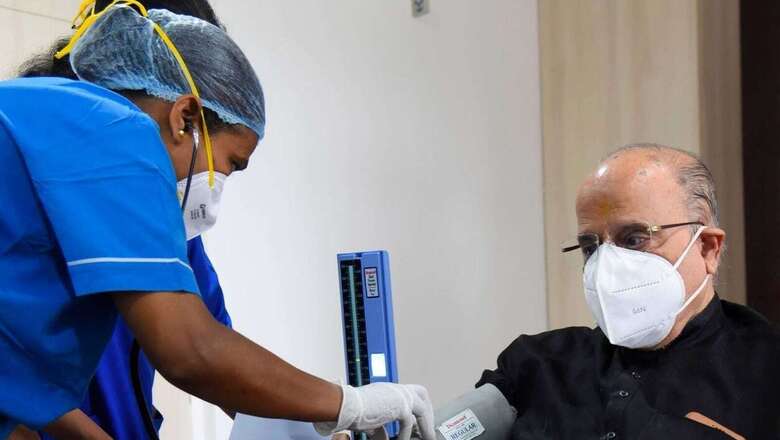
views
In December 2021, as much of India was approaching what is now the third wave of the Covid-19 pandemic, NITI Aayog released the latest edition of its Health Index. The index shows a picture of state-level progress on health indicators corresponding to FY 2019-20. Health systems across the country have been forced to evolve since then, jolted by the pandemic’s three waves. However, data from the index show a neglected state of affairs across critical aspects of health systems governance pre-Covid.
The index has three domains: Health Outcomes, Governance and Information, and Key Inputs and Processes. The Governance and Information domain is covered by a total of four indicators:
* Average occupancy of key state-level administrators over a three-year period,
* Average occupancy of district-level administrators over a three-year period,
* Time taken (in days) for transferring funds under the National Health Mission (NHM) from state treasury to implementation agency,
* Percentage deviation of Health Management Information System data on institutional deliveries from data in the Sample Registration System.
The average occupancy of administrators indicates stability of their tenure which plays a key role in maintaining consistency of service delivery and improving accountability across departments. Similarly, the time taken in transfer of funds to implementation agencies is crucial for effectiveness of service delivery in a critical sector like health. This article looks at progress on the governance domain of the index only for 19 large states as for smaller states and UTs all four indicators are not applicable.
Lack of Stability of Tenure
The overall scores on the governance and information domain, for 19 large states, show a mixed bag of results. Eight out of 19 states recorded a decline in their scores on this domain between 2018-19 and 2019-20 with Himachal Pradesh declining by a massive 18 percentage points. Additionally, Bihar and Jharkhand recorded a negligible increase of 0.2 and 0.4 percentage points. This means that more than 50% of large states saw a declining or negligible progress on health systems governance. Assam, Kerala and Chhattisgarh recorded the highest increase in score on account of an increase in average occupancy of Chief Medical Officers (CMO) at the district level.
On average, the index shows, the tenure of state-level and district-level officers lasted just over a year (14-15 months), reflecting a high frequency of transfers across and within states. Over 50% of the large states recorded a net decrease in occupancy of state-level positions like Principal Secretary, Mission Director (NHM) and Director (Health Services). Occupancy of these three positions was 12 months or less in half of the large states with Karnataka having an occupancy of just 7.7 months. The average occupancy of district-level positions like CMO was even worse with 13 out of 19 states (about 68%) recording a net decline. Odisha had the least stable occupancy of district-level positions at 5.1 months. Seen over a five-year period between 2014-15 and 2019-20, district-level average occupancy declined in over 50% of the large states. This general lack of stability of tenure shows that across most states in India, institutions responsible for delivery of health services are run inefficiently as personnel enter and exit frequently. Tenure stability is one of the key aspects of cadre management, and in general, a good governance practice.
Slow Pace of Fund Transfer
On the aspect of time taken in funds transfer (under the centrally sponsored NHM) from state treasury to implementation agency, the results show poor performance across states barring few exceptions. In 10 out of 19 states (over 50%), the time taken increased during 2018-19 and 2019-20. Himachal Pradesh and Telangana were the worst performers on this aspect with fund transfer period increasing by 152 days and 115 days respectively over the base year. While Punjab recorded the highest improvement with a decline of 208 days in 2019-20 compared to 2018-19, it still took 134 days (4.5 months) for the state to transfer funds to its implementation agencies. Overall, seven states took more than 90 days to transfer funds to state-wide implementation agencies. For instance, while in Himachal Pradesh fund transfer takes a whopping 186 days (over 6 months), in Uttar Pradesh it takes 124 days (over 4 months), and in Jharkhand and Karnataka it takes 121 days (over 4 months) each. Overall, transfer of funds under India’s flagship health scheme happens at a snail’s pace across most states affecting service delivery as well as the capacity of implementation agencies. This issue becomes even more critical considering the stagnant state of child and maternal health indicators in the country as per the latest findings of NFHS-5.
Concluding Remarks
The above-mentioned issues with health systems governance show only part of the problem. The Health Index identifies several limitations that affect its ability to fully analyse the extent of health systems governance in states. On a general level, the existing quality of data across states is questionable or not recorded on an annual basis, thus limiting the scope of the index. This is true for data related to aspects such as infectious diseases, non-communicable diseases (NCDs), mental health, and governance. For some indicators, particularly Mortality Rates, only larger states could provide data, thus keeping 8 small states and 7 Union Territories out of the purview of analysis. The index also reports a general lack of detailed records across states for crucial aspects like shortfall of personnel and district hospitals with functional Critical Care Units.
Notwithstanding these limitations, the index provides a much-needed hindsight for state-level administrators to gauge the responsiveness of health systems during the pandemic. It is clear that health systems governance in India is laden with inefficiencies related to operations, finances, cadre management, and data collection. For sustainability of output, consistency of service delivery, and preparedness, tenure stability is as necessary as timely fund transfers and effective monitoring. In such a scenario, data-driven approaches to governance along with increased accountability measures within institutions cannot be stressed enough. One can only hope that the experience of the pandemic has retrofitted India’s ailing health systems with such mechanisms.
Jitendra Bisht is Senior Analyst at SPRF India, a policy think tank based in New Delhi that seeks to make public policy research accessible, holistic and evidence-based. The views expressed in this article are those of the author and do not represent the stand of this publication.
Read all the Latest Opinions here




















Comments
0 comment